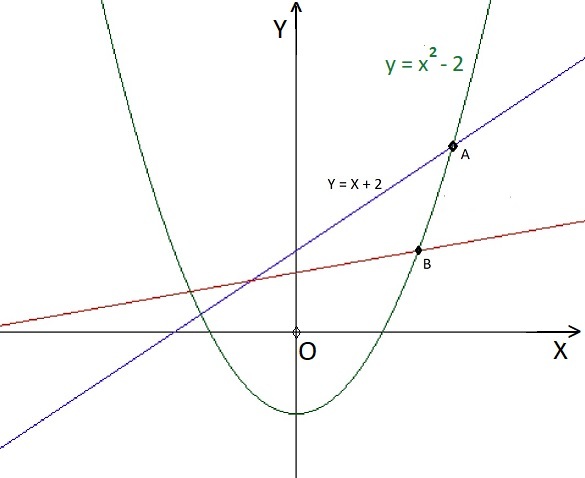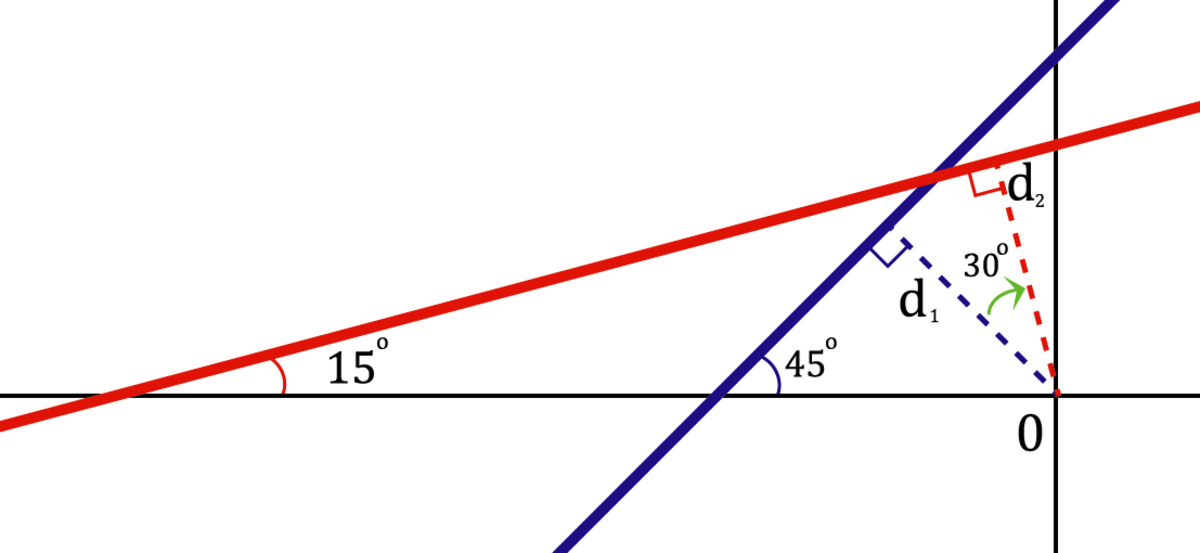Intersection after rotation
In the following graph, the line y = x + 2 intersects the parabola y = x 2 − 2 at point A .
If the given line rotates by 3 0 ∘ clockwise about the origin, determine the new point of intersection B ( x , y ) ?
Enter your answer as x + y x × y ?

The answer is 1.
This section requires Javascript.
You are seeing this because something didn't load right. We suggest you, (a) try
refreshing the page, (b) enabling javascript if it is disabled on your browser and,
finally, (c)
loading the
non-javascript version of this page
. We're sorry about the hassle.
2 solutions
Perfect ....
When a line is rotated about a point, its distance to the point never changes. It is how we find the equation of the second line.
Let d 1 be the distance of the original line from the origin. Using the formula d = a 2 + b 2 ∣ c ∣ to calculate the distance of the line x − y + 2 = 0 to the origin ( 0 , 0 ) , we get d 1 = 2 2 .
Now, because the original line has slope of 1 = tan ( 4 5 ∘ ) , and that it was rotated 3 0 ∘ , then the slope of the second line is tan ( 1 5 ∘ ) = 2 − 3 .

Then, using the the slope-intercept form of a line, the equation of the second line is
y = ( 2 − 3 ) x + b . Since the distance of the second line to the origin is equal to the first distance, that is, d 1 = d 2 , then, using the formula I earlier mentioned, d 2 = a 2 + b 2 ∣ c ∣
2 2 = 1 + ( 2 − 3 ) 2 ∣ b ∣ = 1 + 4 − 4 3 + 3 ∣ b ∣ = 8 − 4 3 ∣ b ∣
∣ b ∣ = 2 4 2 − 3 = 4 1 − 2 3 = 4 ( 2 3 − 2 1 ) = 2 3 − 2 .
Therefore, the equation of the second line is
y = ( 2 − 3 ) x + 2 3 − 2 .
As a last step, to solve for the point where the curve y = x 2 − 2 and the second line intersects, we equate them and we solve for the greater value of x, since it is obvious that B has a greater value of x than their other point of intersection.
( 2 − 3 ) x + 2 3 − 2 = x 2 − 2
x 2 − ( 2 − 3 ) x − 2 3 = ( x − 2 ) ( x + 3 ) = 0
Since x 1 = 2 is greater than x 2 = − 3 , then we use x 1 = 2 and plug it in the equation of the curve.
y = x 2 − 2 = 4 − 2 = 2
Therefore, the coordinate of point B is B ( x , y ) = B ( 2 , 2 ) .
Thus, x + y x × y = 4 4 = 1 .
This is good, But you can apply simple rotation 2 × 2 matrix to the line by 3 0 ∘ about the origin and you will end up with the new line equation. Then find the new intersection with the parabola.
Log in to reply
I used that technique to solve the problem. I made this solution so that even high school students can understand.
Thank you though.
Since y = x + 2 rotates 3 0 ° around the origin, we can apply the rotation formulas x ′ = x cos θ − y sin θ and y ′ = x sin θ + y cos θ to find the new rotated line equation x sin 3 0 ° + y cos 3 0 ° = x cos 3 0 ° − y sin 3 0 ° + 2 which simplifies to y = ( 2 − 3 ) x + 2 ( 3 − 1 ) .
Then the intersection at B occurs when y = ( 2 − 3 ) x + 2 ( 3 − 1 ) = x 2 − 2 , and so x 2 − ( 2 − 3 ) x − 2 3 = 0 or ( x − 2 ) ( x + 3 ) = 0 , which means x = 2 or x = − 3 . Since the point of intersection is to the right of the origin, x = 2 , and so y = x 2 − 2 = 2 2 − 2 = 2 , and x + y x y = 2 + 2 2 ⋅ 2 = 1 .